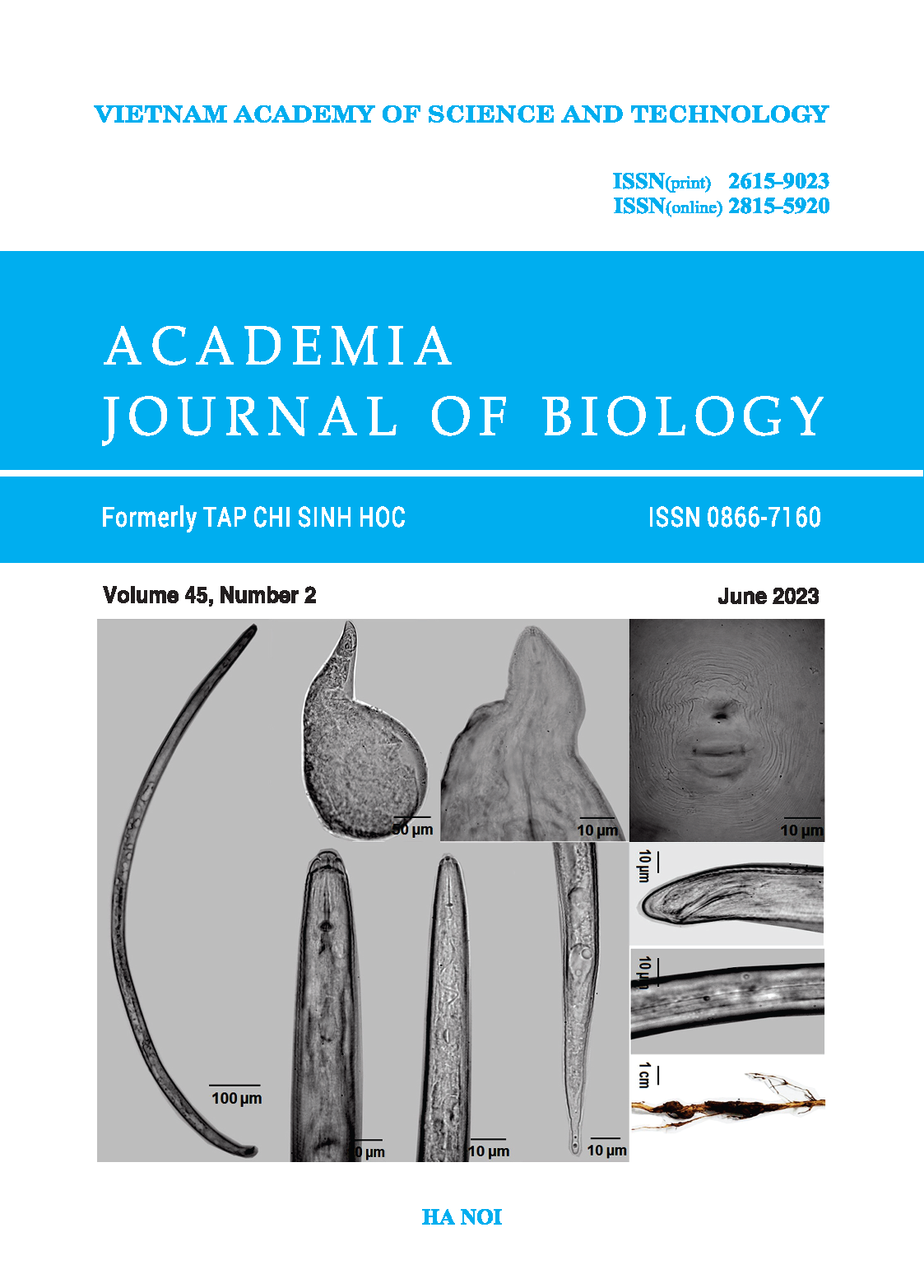First report of root-knot nematode \(\textit{Meloidogyne enterolobii }\) infecting pomelo (\(\textit{Citrus maxima}\) (Burm.) Merri) in Vietnam
Author affiliations
DOI:
https://doi.org/10.15625/2615-9023/18118Keywords:
Emerging pest, molecular, new host, root-knot nematode, taxonomyAbstract
Meloidogyne enterolobii Yang & Eisenback, 1983 is amongst the most aggressive root-knot nematodes, causing significant annual losses worldwide to many crops and emerging in many countries recently. Although plants belonging to the citrus family such as grapefruit and citrus have been reported as non-hosts or poor hosts for M. enterolobii, our study recorded the heavy infection of a root-knot nematode that resembles M. enterolobii on pomelo, a species in the citrus family. The molecular data of D2-D3 of 28S rRNA region, morphometrics, and morphological features of second-stage juveniles, males, and females in the present study have confirmed that the root-knot nematode recovered from pomelo in Vietnam belongs to M. enterolobii. To the best of our knowledge, this represents the first report of M. enterolobii infecting pomelo, providing new insight into the host status of this important pest.
Downloads
References
Altschul S. F., Madden T. L., Schäffer A. A., Zhang J., Zhang Z., Miller W. & Lipman D. J., 1997. Gapped BLAST and PSI-BLAST: a new generation of protein database search programs. Nucleic Acids Research, 25: 3389–3402.
CABI, 2021. Invasive Species Compendium. https://www.cabi.org/isc. In: International, C. (Ed.). Wallingford, UK.
Castagnone-Sereno P., 2012. Meloidogyne enterolobii (= M. mayaguensis): profile of an emerging, highly pathogenic, root-knot nematode species. Nematology, 14: 133–138.
EPPO, 2021. PQR-EPPO database on quarantine pests (available online). http://www.eppo.int.
Iwahori H., Truc N. T. N., Ban D. V. & Ichinose K., 2009. First report of root-knot nematode Meloidogyne enterolobii on guava in Vietnam. Plant disease, 93: 675–675.
Kiewnick S., Dessimoz M. & Franck L., 2009. Effects of the Mi-1 and the N root-knot nematode-resistance gene on infection and reproduction of Meloidogyne enterolobii on tomato and pepper cultivars. Journal of Nematology, 41: 134–139.
Nguyen H. T., Le T. M. L., Nguyen T. D., Liebanas G., Nguyen T. A. D. & Trinh Q. P., 2019. Description of Geocenamus vietnamensis sp. n. (Nematoda: Merliniidae) from Vietnam. Journal of nematology, 51: e2019–25.
Nguyen H. T., Trinh Q. P., Couvreur M., Nguyen T. D. & Bert W., 2021. Description of Hemicycliophora cardamomi sp. n. (Nematoda: Hemicycliophoridae) associated with Amomum longiligulare T. L. Wu and a web-based key for the identification of Hemicycliophora spp. Journal of Helminthology, 95: e2.
Nunn G. B., 1992. Nematode molecular evolution: an investigation of evolutionary patterns among nematodes based upon DNA sequences (Doctoral dissertation). University of Nottingham.
Perry R. N., Moens M. & Starr J. L., 2009. Root-knot nematodes.CABI, pp. 488.
Phan K. L., Le T. M. L., Nguyen H. T. & Duyen T. D., 2020. First report and new molecular and morphological characterizations of root-knot nematode, Meloidogyne javanica, infecting ginger and long coriander in Vietnam. Journal of Nematology, 53: e2021–11.
Philbrick A. N., Adhikari T. B., Louws F. J. & Gorny A. M., 2020. Meloidogyne enterolobii, a major threat to tomato production: current status and future prospects for its management. Frontiers in plant science, 11: 1–13.
Trinh Q. P., Le T. M. L., Nguyen T. D., Le T. T. T. & Nguyen H. T., 2022a. Integrative taxonomy of the aggressive pest
Meloidogyne enterolobii and molecular phylogeny of Meloidogyne spp. based on five gene regions. Australasian Plant Pathology, 51: 345–358.
Trinh Q. P., Le T. M. L., Nguyen T. D., Le T. T. T. & Nguyen H. T., 2022b. Integrative taxonomy of the aggressive pest Meloidogyne enterolobii and molecular phylogeny of Meloidogyne spp. based on five gene regions. Australasian Plant Pathology: 1–14.
Trinh Q. P., Le T. M. L., Nguyen T. D., Nguyen H. T., Liebanas G. & Nguyen T. A. D., 2018. Meloidogyne daklakensis n. sp. (Nematoda: Meloidogynidae), a new root-knot nematode associated with Robusta coffee (Coffea canephora Pierre ex A. Froehner) in the Western Highlands, Vietnam. Journal of Helminthology: 1–13.
Whitehead A. G. & Hemming J. R., 1965. A comparison of some quantitative methods of extracting small vermiform nematodes from soil. Annales of Applied Biology 55: 25–38.
Yang B. & Eisenback J. D., 1983. Meloidogyne enterolobii n. sp. (Meloidogynidae), a root-knot nematode parasitizing pacara earpod tree in China. Journal of Nematology, 15: 381–391.
Downloads
Published
How to Cite
Issue
Section
License
Academia Journal of Biology (AJB) is an open-access and peer-reviewed journal. The articles published in the AJB are licensed under a Creative Commons Attribution-NonCommercial-NoDerivatives 4.0 International License (CC BY-NC-ND 4.0), which permits for immediate free access to the articles to read, download, copy, non-commercial use, distribution and reproduction in any medium, provided the work is properly cited (with a link to the formal publication through the relevant DOI), and without subscription charges or registration barriers. The full details of the CC BY-NC-ND 4.0 License are available at https://creativecommons.org/licenses/by-nc-nd/4.0/.












